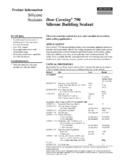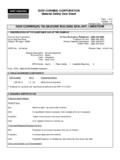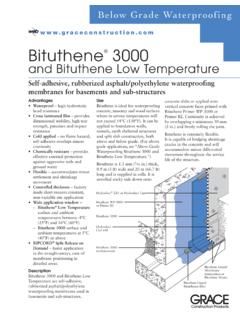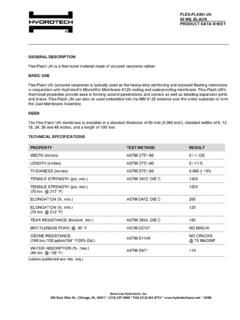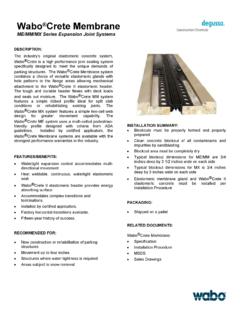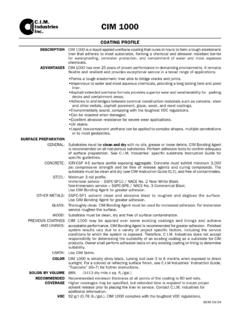Transcription of DOW CORNING CORPORATION Material Safety …
1 DOW CORNING CORPORATION . Material Safety Data Sheet Page: 1 of 8. Version: Revision Date: 2005/04/19. DOW CORNING (R) 790 silicone building sealant , LIMESTONE. 1. PRODUCT AND COMPANY IDENTIFICATION. Dow CORNING CORPORATION 24 Hour Emergency Telephone: (989) 496-5900. South Saginaw Road Customer Service: (989) 496-6000. Midland, Michigan 48686 Product Disposal Information: (989) 496-6315. CHEMTREC: (800) 424-9300. MSDS No.: 04029596 Revision Date: 2005/04/19. Generic Description: silicone elastomer Physical Form: Paste Color: See product name Odor: Amine-like odor NFPA Profile: Health 2 Flammability 1 Instability/Reactivity 0. Note: NFPA = National Fire Protection Association 2. OSHA HAZARDOUS COMPONENTS. CAS Number Wt % Component Name 50791-87-2 - Methylvinyl bis(n-methylacetamido) silane 68952-53-4 - Dimethyl, methylethyl-N-hydroxyethamine siloxane The above components are hazardous as defined in 29 CFR 3. HAZARDS IDENTIFICATION.
2 Potential Health Effects Acute Effects Eye: Direct contact may cause mild irritation. Skin: May cause moderate irritation. Inhalation: Vapor may irritate nose and throat. Vapor overexposure may cause drowsiness. Oral: Low ingestion hazard in normal use. Prolonged/Repeated Exposure Effects Skin: No known applicable information. Inhalation: Overexposure by inhalation may injure the following organ(s): Liver. Kidneys. Testes. Bone marrow. Immune system. DOW CORNING CORPORATION . Material Safety Data Sheet Page: 2 of 8. Version: Revision Date: 2005/04/19. DOW CORNING (R) 790 silicone building sealant , LIMESTONE. Oral: Repeated ingestion or swallowing large amounts may injure internally. Signs and Symptoms of Overexposure No known applicable information. Medical Conditions Aggravated by Exposure No known applicable information. The above listed potential effects of overexposure are based on actual data, results of studies performed upon similar compositions, component data and/or expert review of the product.
3 Please refer to Section 11 for the detailed toxicology information. 4. FIRST AID MEASURES. Eye: Immediately flush with water for 15 minutes. Skin: Remove from skin and wash thoroughly with soap and water or waterless cleanser. Get medical attention if irritation or other ill effects develop or persist. Inhalation: Remove to fresh air. Get medical attention if ill effects persist. Oral: Get medical attention. Comments: Treat according to person's condition and specifics of exposure. 5. FIRE FIGHTING MEASURES. Flash Point: Not applicable. Autoignition Temperature: Not determined. Flammability Limits in Air: Not determined. Extinguishing Media: On large fires use dry chemical, foam or water spray. On small fires use carbon dioxide (CO2), dry chemical or water spray. Water can be used to cool fire exposed containers. Fire Fighting Measures: Self-contained breathing apparatus and protective clothing should be worn in fighting large fires involving chemicals.
4 Determine the need to evacuate or isolate the area according to your local emergency plan. Use water spray to keep fire exposed containers cool. Unusual Fire Hazards: None. Hazardous Decomposition Products Thermal breakdown of this product during fire or very high heat conditions may evolve the following hazardous decomposition products: Metal oxides. Quartz. Carbon oxides and traces of incompletely burned carbon compounds. Formaldehyde. Silicon dioxide. Nitrogen oxides. DOW CORNING CORPORATION . Material Safety Data Sheet Page: 3 of 8. Version: Revision Date: 2005/04/19. DOW CORNING (R) 790 silicone building sealant , LIMESTONE. 6. ACCIDENTAL RELEASE MEASURES. Containment/Clean up: Observe all personal protection equipment recommendations described in Sections 5 and 8. Wipe up or scrape up and contain for salvage or disposal. Clean area as appropriate since spilled materials, even in small quantities, may present a slip hazard.
5 Final cleaning may require use of steam, solvents or detergents. Dispose of saturated absorbant or cleaning materials appropriately, since spontaneous heating may occur. Local, state and federal laws and regulations may apply to releases and disposal of this Material , as well as those materials and items employed in the cleanup of releases. You will need to determine which federal, state and local laws and regulations are applicable. Sections 13 and 15 of this MSDS provide information regarding certain federal and state requirements. Note: See section 8 for Personal Protective Equipment for Spills. Call (989) 496-5900, if additional information is required. 7. HANDLING AND STORAGE. Use with adequate ventilation. Product evolves N-methyl acetamide when exposed to water or humid air. Provide ventilation during use to control N-methyl acetamide within exposure guidelines or use respiratory protection. Avoid eye contact.
6 Avoid skin contact. Do not take internally. Avoid breathing vapor. Keep container closed. Use reasonable care and store away from oxidizing materials. Keep container closed and store away from water or moisture. 8. EXPOSURE CONTROLS / PERSONAL PROTECTION. Component Exposure Limits CAS Number Component Name Exposure Limits 50791-87-2 Methylvinyl bis(n-methylacetamido) silane See N-methyl acetamide comments. N-methyl acetamide is formed on contact with water or humid air. Provide adequate ventilation to control exposures to within Dow CORNING recommended exposure guidelines of 1 ppm (TWA) and 5 ppm (Excursion Limit). Engineering Controls Local Ventilation: Recommended. General Ventilation: Recommended. Personal Protective Equipment for Routine Handling Eyes: Use proper protection - Safety glasses as a minimum. Skin: Wash at mealtime and end of shift. Contaminated clothing and shoes should be removed as soon as practical and thoroughly cleaned before reuse.
7 Chemical protective gloves are recommended. DOW CORNING CORPORATION . Material Safety Data Sheet Page: 4 of 8. Version: Revision Date: 2005/04/19. DOW CORNING (R) 790 silicone building sealant , LIMESTONE. Suitable Gloves: Silver Shield(R). 4H(R). Inhalation: Use respiratory protection unless adequate local exhaust ventilation is provided or exposure assessment demonstrates that exposures are within recommended exposure guidelines. IH. personnel can assist in judging the adequacy of existing engineering controls. Suitable Respirator: General and local exhaust ventilation is recommended to maintain vapor exposures below recommended limits. Where concentrations are above recommended limits or are unknown, appropriate respiratory protection should be worn. Follow OSHA respirator regulations (29. CFR ) and use NIOSH/MSHA approved respirators. Personal Protective Equipment for Spills Eyes: Use full face respirator. Skin: Wash at mealtime and end of shift.
8 Contaminated clothing and shoes should be removed as soon as practical and thoroughly cleaned before reuse. Chemical protective gloves are recommended. Inhalation/Suitable Respiratory protection recommended. Follow OSHA Respirator Regulations (29 CFR. Respirator: ) and use NIOSH/MHSA approved respirators. Protection provided by air purifying respirators against exposure to any hazardous chemical is limited. Use a positive pressure air supplied respirator if there is any potential for uncontrolled release, exposure levels are unknown, or any other circumstance where air purifying respirators may not provide adequate protection. Precautionary Measures: Avoid eye contact. Avoid skin contact. Do not take internally. Avoid breathing vapor. Keep container closed. Use reasonable care. Comments: Product evolves N-methyl acetamide when exposed to water or humid air. Provide ventilation during use to control N-methyl acetamide within exposure guidelines or use respiratory protection.
9 Note: These precautions are for room temperature handling. Use at elevated temperature or aerosol/spray applications may require added precautions. 9. PHYSICAL AND CHEMICAL PROPERTIES. Physical Form: Paste Color: See product name Odor: Amine-like odor Specific Gravity @ 25 C: Viscosity: Not determined. Freezing/Melting Point: Not determined. Boiling Point: Not determined. Vapor Pressure @ 25 C: Not determined. Vapor Density: Not determined. Solubility in Water: Not determined. pH: Not determined. DOW CORNING CORPORATION . Material Safety Data Sheet Page: 5 of 8. Version: Revision Date: 2005/04/19. DOW CORNING (R) 790 silicone building sealant , LIMESTONE. Volatile Content: Not determined. Note: The above information is not intended for use in preparing product specifications. Contact Dow CORNING before writing specifications. 10. STABILITY AND REACTIVITY. Chemical Stability: Stable. Hazardous Hazardous polymerization will not occur.
10 Polymerization: Conditions to Avoid: None. Materials to Avoid: Oxidizing Material can cause a reaction. Water, moisture, or humid air can cause hazardous vapors to form as described in Section 8. 11. TOXICOLOGICAL INFORMATION. Component Toxicology Information Contains Bis(N-methyl acetamido)silane which liberates N-methylacetamide (NMA) during cure. NMA has been shown to cause birth defects in laboratory animals. Special Hazard Information on Components No known applicable information. 12. ECOLOGICAL INFORMATION. Environmental Fate and Distribution Complete information is not yet available. Environmental Effects Complete information is not yet available. Fate and Effects in Waste Water Treatment Plants Complete information is not yet available. Ecotoxicity Classification Criteria Hazard Parameters (LC50 or EC50) High Medium Low Acute Aquatic Toxicity (mg/L) <=1 >1 and <=100 >100. Acute Terrestrial Toxicity <=100 >100 and <= 2000 >2000.
